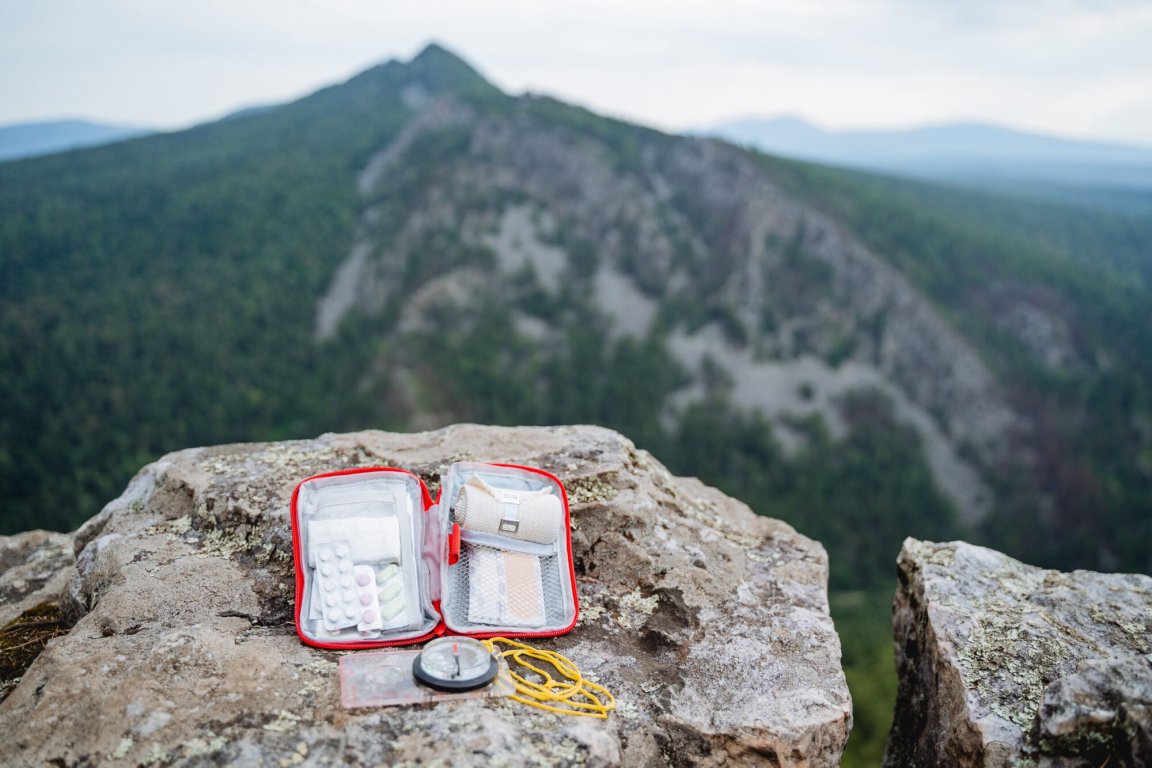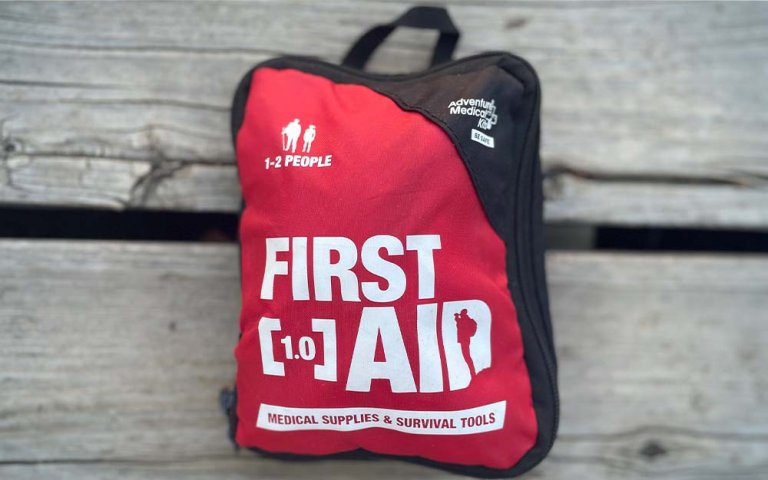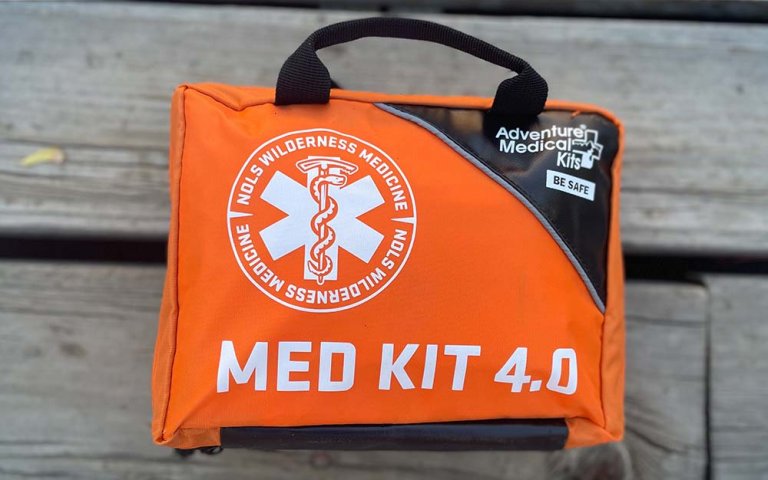We may earn revenue from the products available on this page and participate in affiliate programs. Learn More ›
If you become injured or sick while hiking, your first aid kit’s only job is to get you out of the backcountry safely. You need to be comfortable enough to finish your trip, or capable of getting to a hospital. That’s why finding the best first aid kit for hiking is less about shopping for the perfect watertight box of gauze pads and anti-itch ointment packets, and more about assessing the risks of your particular trip and packing relevant and lightweight supplies.
How I Chose the Best First Aid Kits for Hiking
To get to the bottom of what should be in your first aid kit for hiking, I spoke to Graham Prather, NOLS wilderness medicine education manager. Find out what you should actually bring on day hikes, backpacking trips, and thru-hikes.
What to Include in Your First Aid Kit for Hiking
Knowledge
The most valuable first aid tool you have in the backcountry is your brain. First of all, know where you are, where your bail points are, and where you are going. The best way to help an injured hiking partner is to get them to safety. Whether that’s your home or a hospital, the first step is knowing how to get there.
The most equipped hiking first aid kit in the world is no good to you if you don’t know how to use it. And the more first aid knowledge you have, the better prepared you are to care for someone, or yourself, with limited supplies. A Wilderness First Aid (WFA) course is a great way to not only prepare for the worst, but also shift into a preventative mindset. The best way to stay safe in the backcountry is to avoid injuries in the first place. Prather gave a tried and true example: If you treat a hot spot effectively, you can likely avoid dealing with a blister, infection, and a painful hike out. This list encompasses a quality DIY first aid kit for hiking. Read on to find out how to customize your own.
- Leukotape
- Bandages
- Gauze
- Petroleum jelly ointment
- Gloves
- Syringe
- Tweezers
- Scissors
- Soap
- Ibuprofen
- Acetaminophen
- Aspirin
- Benadryl
- Imodium
- Extra food
- Matches
- Gear repair items
- Iodine or backup water treatment
- Emergency blanket
- Satellite communicator
Wound Care

Blisters and lacerations are very common hiking injuries. First, it’s a good idea to pack medical gloves in case you need to help someone else who’s bleeding. Gloves are hygienic and protect both patient and care-giver. Don’t underestimate the mental calm gloves can provide, too. If a patient is panicking, pulling out medical gloves may put them at ease by creating a cleaner and more professional environment to help them.
Next, you’ll want to clean the area with drinkable water. A syringe is an often overlooked instrument, but the water pressure is hard to replicate in the field. A hydration bladder hose is a decent substitute, but a plastic bag with a hole in it fails to offer the same flushing capabilities. This is where tweezers can come in handy as well. It’s difficult to find a field substitute when plucking out splinters, thorns, or debris. Prather recommends lightly cleaning wounds with soap and water, because alcohol will wipe out all bacteria, including the good kind. Soap is also great for cleaning areas exposed to poison oak or poison ivy before it starts to irritate you.
Traditional bandaids don’t tend to stick very well to dirty, sweaty skin, so I usually opt for Leukotape, a versatile and extremely sticky medical tape that doesn’t budge even when stuffed in a hiking shoe all day. You can use it to cover hot spots or blisters, to secure gauze pads for bloody injuries, and as athletic tape. It comes in a large, heavy roll so I spin a good amount around my lighter for organized and lightweight storage.
Medication
If you’re creating your own first aid kit for hiking, you’ll likely be taking pills out of their original container for lightweight storage. So it’s important to remember or write-down the dosage for each. Knowing the recommended dose and maximum daily dose is important for efficacy and safety. Prather says if you’re in extreme discomfort, it can be advantageous to take both an ibuprofen and acetaminophen (Tylenol) for increased relief.
Benadryl is good for allergies and allergic reactions, and it can make you drowsy. If you frequently get allergies, Prather recommends a non-drowsy pill for hiking like Claritin. I never leave for a multi-night trip without Benadryl. If you have a run in with stinging nettles or poison ivy, or find out on a spring desert trip that you’re allergic to sagebrush, popping a Benadryl before bed might be your last hope for sleep and relief.
Emergency Items
Basic first aid is a no-brainer for hiking, but you should also be prepared with extra emergency items, especially on multi-night trips. I always throw in an extra lightweight backpacking meal, just in case one of my dinners is ruined, someone needs more food, or my trip is unexpectedly extended. You know that Clif Bar flavor you can’t stand, the one that eventually accumulates at the bottom of your variety pack (I’m looking at you, cool mint chocolate)? Prather recommends keeping one of those in your pack as emergency food. You aren’t going to eat it of your own volition, but if you desperately need it, it’ll be there.
Always bring multiple ways to start a fire; keeping matches in your first aid kit is a stellar idea. A flame is another way to sterilize tweezers, a pocket knife, or needle for popping blisters or cleaning a wound. Depending on your trip, a backup water treatment is also a good idea. In the event of an evacuation, a satellite communicator can save precious time.
- Extra food
- Matches
- Gear repair items
- Iodine or backup water treatment
- Emergency blanket
- Satellite communicator
Kids and Dogs
Prather said his first aid kit for hiking doesn’t change much when his young son or dogs tag along. If your dog is injured, caring for its wound will be very similar to caring for your own. Though, Coban, or vet wrap, is a better bandage for wrapping over fur. OL senior staff writer Laura Lancaster makes sure to pack children’s versions of her medications and a thermometer when backpacking with her toddler. Kids get feverish more often than adults, and knowing how high it is for how long can give adults a good idea of the severity of the situation.
Best First Aid Kits for Hiking: Reviews & Recommendations
Buying gauze pads, drug packets, and medical instruments all separately can add up quickly. Often it’s cheaper and easier to buy a pre-made first aid kit for hiking and shake it down for the essentials. Take out what you need for your trip, add any personal items, and store it in an ultralight, waterproof bag or Ziplock. Prather says that any first aid kit from your favorite outdoor shop will likely do the trick, but you can find our recommendations from real-world testing below.
Best Basic: Adventure Medical Adventure First Aid 1.0
Pros
- Covers most of the likely everyday, minor first aid issues you may run into
- The two pockets have room for you to add your own materials (I add a bottle of hand sanitizer and a mini sunscreen)
Cons
- Only covers very basic needs and shouldn’t be relied on in the backcountry
- Tweezers are subpar
Key Features
- Weight: 8 ounces
- Two large plastic pockets
- Contains bandages, over-the-counter medications, moleskin, and wound care
- Mini whistle and compass
This simple first aid kit has enough basic supplies for one person for 1-2 days — or, as I use it, for daily, low-consequence, just-in-case use. Think splinter or minor aches and pains on the trail or around town: “Oh, I have something for that.” I keep this first aid kit in my day pack for a chill hike and in my carry-on when I’m traveling — or even in my bag on a regular day. It’s nothing special when it comes to the impressive scope of first aid kits on this list, but for a basic kit, it has everything you’ll need, and nothing that’s “too much” for minor, daily needs. —Samantha Silverman
Best for Backpacking: NOLS Med Kit 4.0
Pros
- Extensive wound care materials
- Lightweight, yet there’s room to customize your kit
- Includes SOAP notes for communicating a patient’s condition to search and rescue
Cons
- Subpar tweezers
Key Features
- Weight: 1 pound, 26 ounces
- Extensive wound care materials
- Contains a CPR mask, duct tape, irrigation syringe, and triangle bandages for sling and swath
This is the med kit I’ve been taking backpacking for years, and I still won’t backpack with anything else. I have a NOLS Wilderness First Responder certification, and I’ve found this kit has a high emphasis on treating more severe wounds than minor abrasions. If the purpose of a wilderness medical certification is to stabilize a patient until emergency medical services can reach them, then this kit supports that intention. —Samantha Silverman
Read Next: Best First Aid Kits
Things to Consider Before Buying the Best First Aid Kit for Hiking
Comfort
Comfort is highly subjective, so your first aid kit will be pretty personalized. Carry what you need to be comfortable. If you can’t stand itchy bug bites or seem to attract poison oak, bring Hydrocortisone. Pack Goldbond or Vagisil for chafing or monkey butt. If you’re prone to athlete’s foot, include an antifungal. For athletic injuries, kinetic tape or a brace might be a necessity.
Overkill
Maybe you read through this list and thought, “Hmm, seems mighty sparse.” And I, your friendly neighborhood ounce-counter, am here to tell you that weighing down your pack with excessive first aid gear you’ll likely never use is just going to slow you down. Overloading your pack is a good way to bring out injuries. The exception here is any time you’re hiking with firearms or a chainsaw. Prather recommends that hunters and trail crew pack a commercial tourniquet and specifically focus on stop-the-bleed medicine.
When it comes to dislocations, fractures, and broken bones, your first aid kit has the same goal it started with: get you out of the backcountry safely. This is when knowing the maximum dose of over the counter painkillers comes in handy. Instead of packing a commercial splint, Prather saves weight and space by packing another layer instead. He says you can create a successful field split using padding and compression for sufficient rigidity to get an injured hiker to civilization. Trekking poles are hugely helpful in these situations.
FAQs
A first aid kit for hiking becomes more important the further you are from help. If you’re on a remote thru-hike, having basic supplies is essential for making sure you’re capable enough to reach civilization in an emergency. You could get away with some bandages and an extra granola bar on a short, local day hike.
Practicing with your gear and listening to your body are great ways to prevent hiking injuries. Break in your shoes ahead of a big mission and make sure your backpack is comfortable. Drink enough water, eat enough food, and take breaks if you need them.
Taping your feet where hot spots arise can be a good way to avoid blisters on trail.
Read Next: Should You Pop a Blister When Hiking?
Final Thoughts on the Best First Aid Kits for Hiking
Instead of packing 200 bandaids that will fall off at the first strong breeze, the best way to stay safe in the backcountry is to not get hurt in the first place. Prevent injuries by hiking smart: know your gear, know your route, and listen to your body. But the best first aid kits for hiking, DIYed or purchased, will ensure you’re prepared for the most common hiking injuries.
- Best Basic: Adventure Medical Adventure First Aid 1.0
- Best for Backpacking: NOLS Med Kit 4.0


